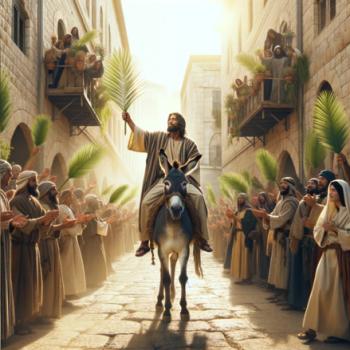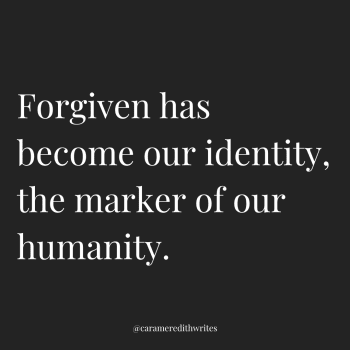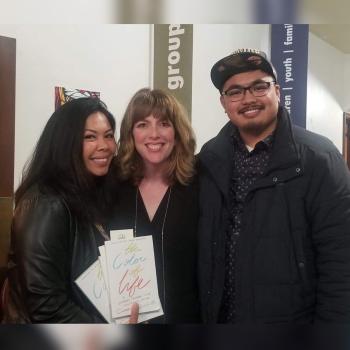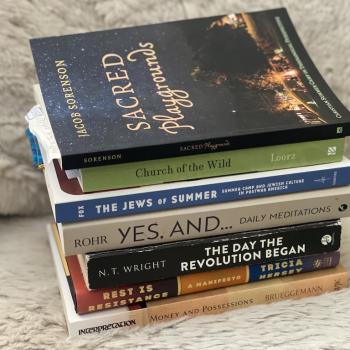A homily on Luke 2:22-40, given at Trinity Church on February 2, 2020. Enjoy!

As I thought about this morning, I kept thinking about the word presentation.
Presentation, if we look up the actual definition, means “the giving of something to someone, especially as part of a formal ceremony.”
For me, I had to rid my mind of its association with our friends over at Microsoft, for this was and is something so much bigger, so much deeper. I had to stop equating the word “presentation” with “performance,” because when something is presented, a gift is offered. A gift is given.
Here I am, the presentation almost seems to say. And here’s what I’ve got.
In a way, this act of presenting is then the most vulnerable place any of us can be in, because when we put ourselves into a place of presenting and of giving a gift, we don’t know the end result. We don’t know how the gift we are giving, which is most often ourselves, will be received.
And in a way, this forces us to strip off our pretenses. Because it’s just us at the end of the day – plain ol’ regular, beautiful, broken, perfectly-loved-by-God us.
We see this at weddings and we see this at baptisms, and we see this at funerals too.
Nearly two years ago, I stood under the dome at St Mark’s Cathedral in Seattle, Washington. Nearly 200 people, from children and teenagers to grownups well into their seventies and eighties gathered near the center to present themselves for baptism and for conversion and for rededication into the Episcopal Church.
I’d been a Christian for as long as I could remember – I mean, I’d practically popped out of the womb believing in the eight pound, six ounce, newborn infant Jesus, but after a move up to Seattle a couple of years ago (which resulted in coming back down to the Bay Area twenty months later) – everything in my life felt upended and untethered and unknown.
As it so happened, God met me at Saint Andrew’s Episcopal church on the corner of 80th Street and 1stAvenue. And for the first time in a long time, everything just made sense.
The theology made sense. The incense made sense. The crossing and the rising and kneeling made sense. The homily and the eucharist made sense. The inclusion made sense. The Jesus I’d so long felt absent from made sense. And so, after nearly four decades on the evangelical side of the pond, this step of baptism into the Episcopal Church made sense.
Y’all, there I was, dressed in my Sunday best on a Saturday morning under drizzly, gray skies, singing the songs sung by thousands of tongues and praying the prayers that had been prayed for hundreds of years.
I remember how my heart beat wildly in my chest as Bishop Rickel came near, as he prayed what seemed to be the same prayer over every person kneeling there.
But it wasn’t the same thing. It wasn’t the same prayer.
It was different and it was holy because it was infused with the power of the Spirit, and because in this presentation, it wasn’t about anyone else: it was just about God and me.
Here I am, I kind of seemed to be saying. Here’s what I’ve got.
It was almost a take it or leave it kind of Jesus dare – Big Pie in the Sky God, above and below and all around me. If you really want me, well, here I am. And THIS is what you’re getting.
This mess, this real me? I’m all yours, if you really want it, if you’ll really have me.
That day, as the Bishop neared, I remember how my throat began to tighten. I remember how my eyes filled with tears. I remember how by the time the Bishop placed his hands on my head, I was a hiccupping, sobbing, bawling-like-a-baby mess.
After all, in the journey and then in the day’s presentation, GOD had met me there. God had found me, just as God finds you. And God had responded to that Here I am, here’s what I’ve got whisper.
And it’s almost like God turned the response back on me, back on us: so, what then do you say?
I doubt the element of presentation was any different for Mary and Joseph that day in the temple either, as we listened to in today’s Gospel Reading.
Luke 2:22-40 celebrates the Presentation of Our Lord. For some traditions, today marks the end of the season of Epiphany, the end of a season of God-with-us realizations. For others – and I think this is where we find ourselves today – when Mary and Joseph brought Jesus to the temple for circumcision and to present him as an offering to the Lord, it’s almost like they too were whispering, Here he is. Here’s what we’ve got. And in the end, an invitation is also extended to us: for during the continued season of Epiphany, we are left to wonder what this particular presentation means to us, especially when it paints Jesus himself in a whole new light.
Because, here’s the thing: Luke, the writer of this book, lets the reader in on two HUGE clues in the first paragraph alone, so let me get theologically nerdy on you for a minute here.
First, the fact that Mary and Joseph showed up at the temple 40 days after the birth of their son, shows how seriously they took the tenants of their religion. They are observant Jews who observe (what we would refer to as) Old Testament purity laws; so when this pair showed up to the temple that day, their presence alone reinforced to God and to everyone else around them that they took seriously Jesus’ cultural and religious Jewish identity.
This is key for us to remember, especially in our Americanized, Christianized context. For some of us, myself included, we forget the significance of what meant that Jesus was a dark-skinned Jewish man, weathered by the elements of sun and sea – especially when we find ourselves operating in worlds, both inside and outside the Church, that look and think and believe mostly like us.
But second, when Mary and Joseph offer two turtledoves as a sacrifice, that’s Luke’s way of letting the reader know where in Jewish society Jesus’ family stands. And the “where” of it is among the poor. When, in Jewish culture, two turtledoves are presented as a sacrifice, it’s because the family is following Levitical code – the rules, in other words, laid out in the Old Testament, for turtledoves were the offering of the poor, the only offering the poor could afford to give.
So when Jesus then talks about caring for the poor and the marginalized among us, he’s not merely championing the cause of the poor …he’s championing the cause of HIMSELF. He’s championing his experience as a poor person, as someone who was born on the economic margins of society.
And I don’t know about you, but the significance of Jesus being presented as a poor, Jewish, brown-skinned altogether changes the invitation for me.
No longer is God the God of the successful, but God is the God of the weak, of the brokenhearted, of those who are downtrodden.
Is that you?
No longer is God the God of those who can afford good lawyers, who went to all the right schools and received the best education, who know all the Sunday School answers, but God is the God of those who are on free and reduced lunch, who beg and plead on the side of the street.
Is that you?
So when Jesus, just two chapters (and a whole lot of years later) then declares that “The Spirit of the Lord is on me, because he has anointed me to proclaim good news to the poor. He has sent me to proclaim freedom for the prisoners and recovery of sight for the blind, to set the oppressed free, to proclaim the year of the Lord’s favor,” he’s saying here’s who I am, because here’s who I’ve been all along.
Here I am, Jesus proclaims. And here’s what I’ve got.
The presentation of Jesus declared who he was, from birth. And the presentation of Jesus that day in the temple begs us to see Jesus as he really was and not as we’ve sometimes created him to be.
Who are we then going to be, when it comes to caring for the poor – for the estimated 43% of poor people who call our country home? Who are we then going to be, when it comes to not only engaging in conversations of justice and equity, but of doing something about justice and equity? For God is a God of justice; as theologian Kelly Brown Douglas says, if there is a God, there is justice. And if there is justice, there is hope. So, who are we then going to be, when it comes to discovering and being discovered by God, all over again, as if for the very first time?
How then are we going to respond?
One last thought: on the back of my desk, where I wrote this sermon, sits a paper airplane, hand-crafted by my favorite seven-year old (who also happens to be called my son).
“Mama, I made this for you,” he once said, handing it to me. And while I usually take such incredible paper gifts, throw them once and then zoom them into the recycle bin, I didn’t do that with this one. Because on the side of one of the wrinkly, crinkly wings, he had written, “I love you, Mama,” in simple, handwritten script.
It was his gift to me, his apology for a personality clash earlier in that afternoon.
My response was a hug. My response was thank you. My response was not sticking that paper airplane in the recycle bin, but letting it sit there, to remind me of his gift to me.
Here I am, Mama. Here’s what I’ve got.
I’m asked to respond to this declaration, this presentation, this offering, this gift. And when it comes to the text this morning, we all are, I suppose.
—
I want to be sure to point you to Working Preacher, which has my favorite commentary on the text and provided a ton of theological insight for this sermon. Otherwise, click here if you want to listen to the sermon.

















